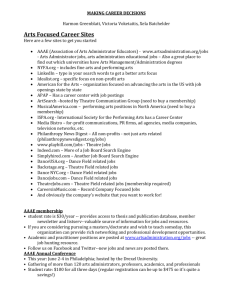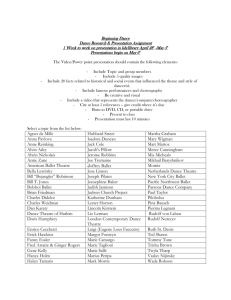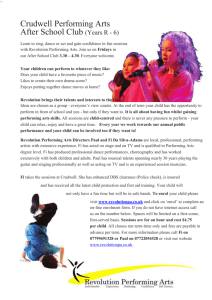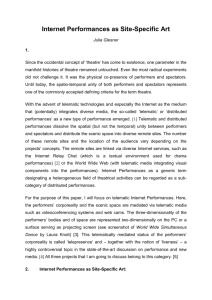Music and Movement and Aesthetic Response/Critique
advertisement
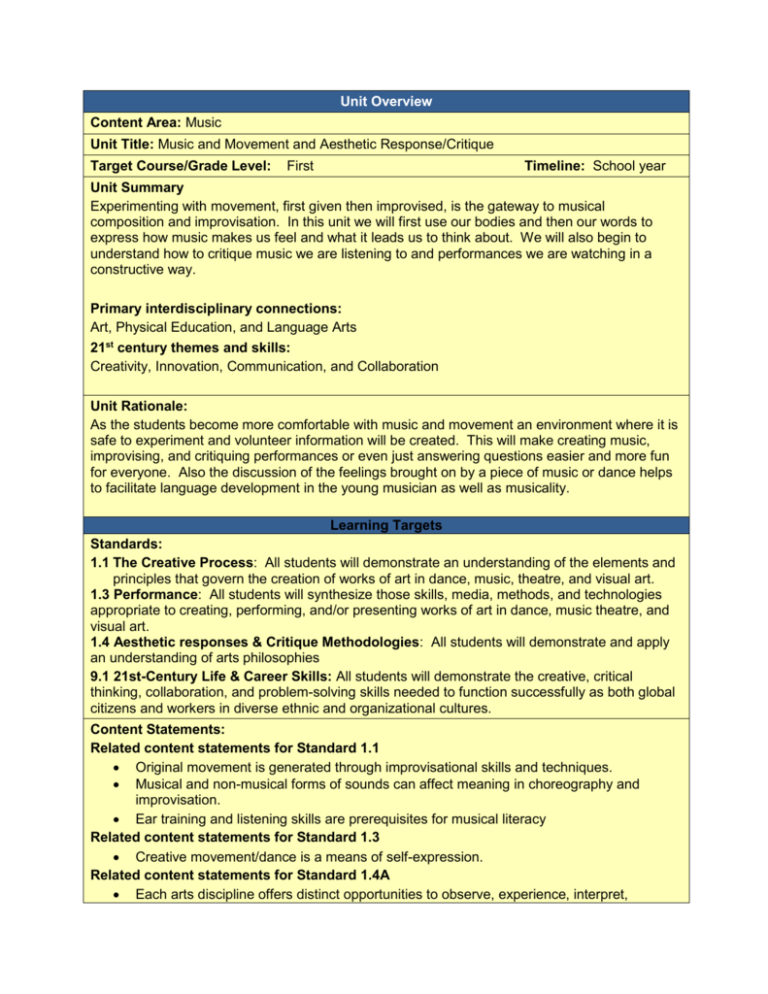
Unit Overview Content Area: Music Unit Title: Music and Movement and Aesthetic Response/Critique Target Course/Grade Level: First Timeline: School year Unit Summary Experimenting with movement, first given then improvised, is the gateway to musical composition and improvisation. In this unit we will first use our bodies and then our words to express how music makes us feel and what it leads us to think about. We will also begin to understand how to critique music we are listening to and performances we are watching in a constructive way. Primary interdisciplinary connections: Art, Physical Education, and Language Arts 21st century themes and skills: Creativity, Innovation, Communication, and Collaboration Unit Rationale: As the students become more comfortable with music and movement an environment where it is safe to experiment and volunteer information will be created. This will make creating music, improvising, and critiquing performances or even just answering questions easier and more fun for everyone. Also the discussion of the feelings brought on by a piece of music or dance helps to facilitate language development in the young musician as well as musicality. Learning Targets Standards: 1.1 The Creative Process: All students will demonstrate an understanding of the elements and principles that govern the creation of works of art in dance, music, theatre, and visual art. 1.3 Performance: All students will synthesize those skills, media, methods, and technologies appropriate to creating, performing, and/or presenting works of art in dance, music theatre, and visual art. 1.4 Aesthetic responses & Critique Methodologies: All students will demonstrate and apply an understanding of arts philosophies 9.1 21st-Century Life & Career Skills: All students will demonstrate the creative, critical thinking, collaboration, and problem-solving skills needed to function successfully as both global citizens and workers in diverse ethnic and organizational cultures. Content Statements: Related content statements for Standard 1.1 Original movement is generated through improvisational skills and techniques. Musical and non-musical forms of sounds can affect meaning in choreography and improvisation. Ear training and listening skills are prerequisites for musical literacy Related content statements for Standard 1.3 Creative movement/dance is a means of self-expression. Related content statements for Standard 1.4A Each arts discipline offers distinct opportunities to observe, experience, interpret, appreciate, and respond to works of art and beauty in the everyday world. Active listening with focus, intent, and understanding is an important component of full appreciation of the performing arts and the foundation for language development. Each arts discipline (dance, music, theatre, and visual art) has distinct characteristics, as do the artists who create them. Related content statements for Standard 1.4B Relative merits of works of art can be qualitatively and quantitatively assessed using observable criteria Constructive criticism is an important evaluative tool that enables artists to communicate more effectively. Related content statements for Standard 9.1A The ability to recognize a problem and apply critical thinking and problem-solving skills to solve the problem is a lifelong skill that develops over time. Related content statements for Standard 9.1B Brainstorming activities enhance creative and innovative thinking in individual and group goal setting and problem solving. CPI # 1.1.2.A.2 1.1.5.A.3 1.1.2.B.1 1.3.P.A.1 1.3.P.A.2 1.3.P.A.3 1.3.P.A.4 1.3.P.A.6 1.4.P.A.1 1.4.P.A.2 1.4.P.A.3 1.4.P.A.4 1.4.P.A.5 1.4.P.A.6 1.4.P.A.7 1.4.2.A.3 Cumulative Progress Indicator (CPI) Use improvisation to discover new movement to fulfill the intent of the choreography. Determine how accompaniment (such as sound, spoken text, or silence) can affect choreography and improvisation. Explore the elements of music through verbal and written responses to diverse aural prompts and printed scores. Move the body in a variety of ways, with and without music. Respond to changes in tempo and a variety of musical rhythms through body movement. Participate in simple sequences of movements. Define and maintain personal space, concentration and focus during creative movement/dance performances. Use movement/dance to convey meaning around a theme or to show feelings. Describe feelings and reactions in response to a creative movement/dance performance. Describe feelings and reactions in response to diverse musical genres and styles. Describe feelings and reactions and respond in an increasingly informed manner to stories and dramatic performances. Describe feelings and reactions and make increasingly thoughtful observations in response to a variety of culturally diverse works of art and objects in the everyday world. Begin to demonstrate appropriate audience skills during creative movement and dance performances. Begin to demonstrate appropriate audience skills during recordings and music performances. Begin to demonstrate appropriate audience skills during storytelling and performances. Use imagination to create a story based on an arts experience that communicated 1.4.2.B.1 1.4.2.B.2 9.1.4.A.1 9.1.4.A.5 an emotion or feeling, and tell the story through each of the four arts disciplines (dance, music, theatre, and visual art). Observe the basic arts elements in performances and exhibitions and use them to formulate objective assessments of artworks in dance, music, theatre, and visual art. Apply the principles of positive critique in giving and receiving responses to performances. Recognize a problem and brainstorm ways to solve the problem individually or collaboratively. Apply critical thinking and problem-solving skills in classroom and family settings. 9.1.4.B.1 Participate in brainstorming sessions to seek information, ideas, and strategies that foster creative thinking. Unit Essential Questions Unit Enduring Understandings How can we move our bodies in a way We can respond to different tempi and that reflects the music to which we are meters with locomotor or non-locomotor moving? movements. What does silence look like? Beat, meter, and duration can be represented with movement. How does music make you feel? What makes a musical piece like a Music can help the listener feel a certain story? emotion. What is mood in music? Music is an art form which can lead the listener to have their own feelings and experience. Unit Learning Targets Students will ... Perform simultaneous imitation using movement, instruments, and vocal sounds. Distinguish faster from slower tempi. Distinguish louder from softer dynamics. Perform beat (speak, pat, clap, play, and step). Explore speech material for inflection, improvisation, and rhythm. Imitate movement motives in place; later in space. Imitate rhythmic motives. Distinguish higher from lower pitches with movement. Perform the beat simultaneously with a spoken text. Sing melody and play the beat simultaneously. Show mood of music, and emotions felt with movement, given then improvised. Critique given pieces of music in a constructive fashion. Evidence of Learning Summative Assessment Pre-assessment, participation, performance and observation, self and group assessment, question and answer, classroom discussion, and games. Equipment needed: Folksong CD’s, piano or keyboard, rhythm sticks, various hand percussion instruments, poly spots, mallet percussion instruments, various supplemental materials, books, and music. Teacher Instructional Resources: Music Express Subscription Music K-8 Subscription Tempo Magazine Kodaly in the Classroom by Linda Rann Discovering Orff by Jane Franzee Orff-Schulwerk Applications for the Classroom by Brigitte Warner Formative Assessments Self and group assessment and concerts. Integration of Technology: Smart Board Technology Resources: Click the links below to access additional resources used to design this unit: www.classicsforkids.com www.musick8.com www.menc.org www.acda.org www.sfskids.org Opportunities for Differentiation: Differentiate by student need, interest and readiness level. Teacher Notes:


